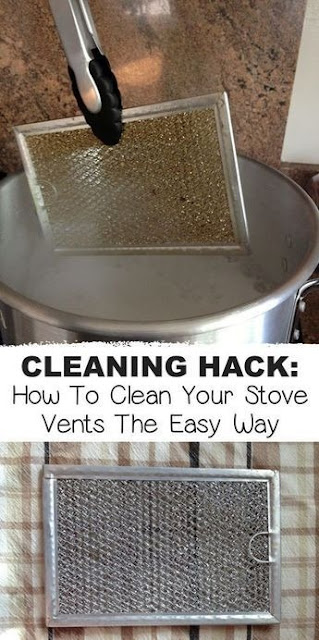There’s nothing like seeing the transformation of a dirty greasy stove after a thorough cleaning. I discovered a great and simple cleaning method that I would like to share with you. I first discovered this technique on Jillee’s One Good Thing blog, and it’s been a game-changer ever since.
Let’s take a look at the previous state of my filters: an unappetizing sight, isn’t it? The buildup of grease and grime on them made me feel uncomfortable thinking of them flying over my food while I was cooking.
To clean your stove vents, you will need a large saucepan and baking soda. Important tip: If your pans are non-stick, it is recommended to use a stainless steel pan instead. I have one dedicated to this cleaning.
Starting by boiling pot of water. Once it bubbles vigorously, sprinkle baking soda. The exact amount depends on the volume of the water, but don’t be surprised when it starts to fizz – that’s a good sign! Add baking soda slowly to avoid excess. Once it fizzes enough, use tongs to carefully plunge the filters into the jar.
As you can see in these pictures, the water is sloshing around the filters and the grease is starting to come off.
Starting by boiling pot of water. Once it bubbles vigorously, sprinkle baking soda. The exact amount depends on the volume of the water, but don’t be surprised when it starts to fizz – that’s a good sign! Add baking soda slowly to avoid excess. Once it fizzes enough, use tongs to carefully plunge the filters into the jar.
I left mine in the boiling solution for about a minute – manageable since the filters are so small. If you have larger filters, you may need to clean them in half.
After extraction, it is amazing to see the fat filters transformed into a brand new state. Knowing these clean filters are on top of my food while I’m cooking brings peace of mind. Plus, removing that grease and grime can help reduce unwanted cooking odors.
For subsequent filters, I reused the water in the bowl, just adding more baking soda to keep the fizz going. The end result was sparkling clean filters!
Although your pot may look a little dirty afterwards, it is relatively easy to clean. When it comes to wastewater disposal, I suggest disposing of it in a remote area of your garden, out of reach of pets or children. This is to prevent greasy water from coating your pipes or harming the environment.
This is it! This process took less than 10 minutes from start to finish. I hope you find it as effective and simple as I do!

